Za’atar Blends From Different Regions
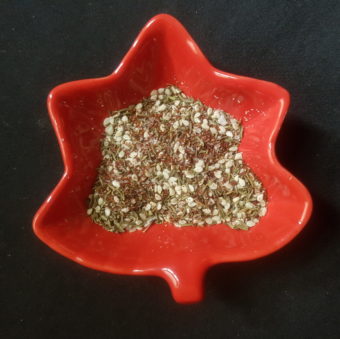
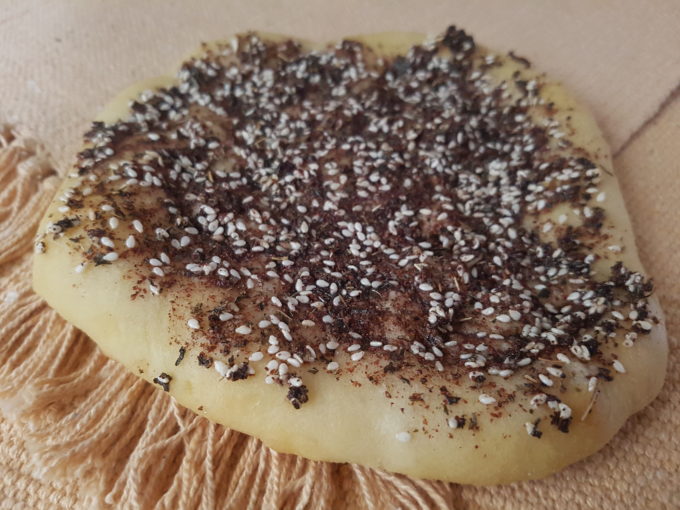
Manakish – Middle Eastern Flat Bread ‘Pizza’ topped with Za’atar
Classic Za’atar | Hyssop Substitute Za’atar | Syrian Za’atar | Turkish Za’atar | Dukkah Za’atar | Semiserious Za’atar Blend
In general za’atar (with a similar name in both Arabic and Hebrew) simply refers to any number of wild herbs that grow in the Fertile Crescent. With the word “za’atar” one could be speaking of a kind of local oregano, thyme, basil thyme, or even savory, however, it is most aggressively associated with Origanum syriacum, a kind of bitter mint or wild oregano, also known as Hyssop. When this particular herb, or any combination of the others, is mixed with toasted sesame seeds and salt, and typically sumac, the condiment is also simply referred to as Za’atar. From there other spices are sometimes added, and different regions have different preferences. They call it a condiment and not a spice because it isn’t usually used within a dish. Think of the way you use mustard for your hotdog or fries, versus how it might be added to homemade barbecue sauce or chili… then don’t… people don’t usually add za’atar to a sauce or a stew. If you want some of those flavors, (hyssop, wild thyme, or sumac) in your sauce, then you should probably be adding them separately.
A note about pre-purchased blends: Although sumac has a great lemon-y flavor on it’s own, some za’atar blends also include lemon zest or citric acid. It is easy to believe that the inclusion of citric acid might be a bit of a price cheating way to replace the sumac.
There are many uses for Za’atar.
It is most commonly eaten at breakfast or lunch with bread that has been dipped in olive oil and then za’atar. In Syria and Turkey they also add pomogranate molasas to the olive oil.
Here are some other suggestions:
- Over Eggs
- On Oatmeal
- On Yogurt/Labeneh
- Over Tomatoes
- On Roasted Vegetables like Cauliflower and Potatoes
- Over Roasted Meats
- For Kababs
- On Saffron Rice
- On Seafood, Specifically:
- Lemony Garlic Shrimp or Scallops
- White Fish
- And it’s great with Smoked Salmon
- Or to coat a smoked salmon cheese ball
- Added to mayo/sour cream or other dips
- With Hummus
- In Pastries
- To Season Sandwiches
- Such as ground lamb on flat bread
- Added to other spice blends
- To top Manakeesh – Middle Eastern ‘Pizza’
- On or in Kaak – Lebanese Purse Bread
- In Za’atar Fteer/Aqras Zaatar/Fatayer Fallahi: an oily yet crunchy flatbread stuffed with za’atar akhdar (fresh za’atar leaf salad), onions, and sumac.

Classic Za’atar
Though the origins of Za’atar blends will be debated until the end of time, through research I have found that the most common, basic, or perhaps classic za’atar seems to come from the Palestine, Israel, Southern Lebanon areas. That being said, there are still variations within it. For instance, hyssop is now very difficult to come by so almost everyone uses wild thyme. The Jewish families tend to add dill to their mix, while Lebanese sometimes include orange zest or caraway. Farther south in Jordan the percentage of sumac is much higher so their za’atars tend to be much more red.
Though hugely popular and a staple among every nation and tribe of the Middle East, Palestinian refugees have a particularly strong connection to this condiment, as a way to connect with their homeland. The plant itself has come to symbolize their need to never give up, and to hold on to their roots.
As for this recipe, just keep in mind that every single family makes their own za’atar a preferred way. The ‘spin-ofs’ I offer are simply generalizations. Don’t be afraid to adjust the recipe to your own specific likes.
[expand title=”See Classic Za’atar Recipe” swaptitle=”Hide Recipe” elwrapclass=”colomat-class”]
Classic Za’atar (With Regional Spin-Offs)
By: Semiserious Chefs
Makes: 6 1/2 – 10 teaspoons Za’atar
Ingredients:
- 2 t Thyme
- 2 t Sumac
- 2 t Toasted Sesame Seeds
- 1/2 t Sea Salt
Spin-Ofs:
- For a Green Aromatic Za’atar : Add 1 teaspoon Oregano and a couple more pinches of salt
- For a Red Jordanian Za’atar: Add another tablespoon of Sumac and 1/4 teaspoon of salt
- For a Lebanese Style Za’atar: 1/8 teaspoons ground Caraway, Anise, and/or 1/4 teaspoon Orange Zest
Directions:
- Grind the green herb[s] using a mortar and pestle, as desired.
- Add the remaining ingredients to a small dish and stir to incorporate.
[/expand]
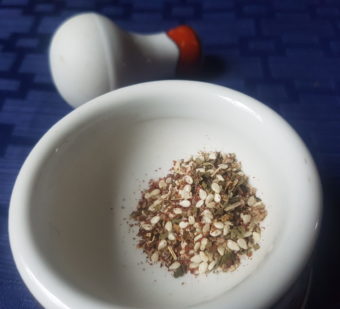
Hyssop Substitute Za’atar
The Levant plant, hyssop, is the most traditional to use for za’atar, but that plant is now under protection from extinction, so the most common herb of choice has become wild thyme. Another good substitute for hyssop is the combination of either thyme+mint or sage+mint. I find the mint and sage mix to be exceptionally fresh, preferring it in my own personal blend.
[expand title=”See Hyssop Substitute Za’atar Recipe” swaptitle=”Hide Recipe” elwrapclass=”colomat-class”]
Hyssop Substitute Za’atar
By: Semiserious Chefs
Makes: 6 1/2 teaspoons Za’atar
Ingredients:
- 1 t each dried Mint and Thyme
- OR 1 t each dried Mint and Rubbed Sage
- 2 t Sumac
- 2 t Toasted Sesame Seeds
- 1/2 t Sea Salt
Directions:
- Gently grind the green herbs with a mortar and pestle.
- Add the sumac and salt, and stir.
[/expand]
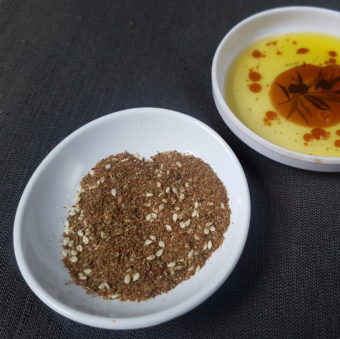
Syrian Za’atar
Moving North, Syria has historically been right in the middle of the spice trade routes with India, and this is reflected in the addition of several flavors common to their za’atar blends. Most specifically this would be cumin and coriander, but some blends also contain small amounts of anise. When we move on to the Turkish inspired recipe, you will see the addition of ground nuts. Some places within Syria, such as Aleppo very near the boarder, also play with this notion by adding ground peanuts or almonds. I leave that as optional for the recipe below, as it isn’t necessarily that common throughout the nation as a whole. Interestingly, the addition of these extra spices sort of leaves the actual za’atar in their za’atar, in the dust.
[expand title=”See Syrian Za’atar Recipe” swaptitle=”Hide Recipe” elwrapclass=”colomat-class”]
Syrian Za’atar
By: Semiserious Chefs
Makes: 3+ tablespoons of Za’atar
Ingredients:
- 1 t ground cumin
- 1 t ground coriander
- 2 t thyme
- 2 t sumac
- 1 t sea salt
- 2 t toasted sesame seeds
- Optional: 1-2 t ground peanuts or cashews
Directions:
- Add the cumin, coriander, thyme, sumac, and salt to a mortar and pestle. Grind until well incorporated.
- Add the sesame seeds and stir.
[/expand]
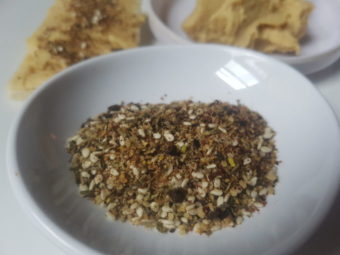
Turkish Za’atar
As we’ve moved around the map now, trying different variations of za’atar, arriving in Turkey a much more ‘meaty’ za’atar emerges. From what I’ve studied, though a huge and varied culture all it’s own, it’s quite common to see the addition of ground cooked chickpeas in a Turkish family’s za’atar, along with one of Turkey’s staple nuts, pistachio. They of-course still use wild thyme, sumac, and sesame seeds, but every corner of the country has their own additional preference of spices. With this diversity in mind I have created my own take on a Turkish Za’atar.
It has the classic thyme, sumac, and sesame seeds, but in lieu of the ground roasted chickpeas*, my recipe uses shelled hemp seeds. The reason for this is that simply using ground raw chickpea flour, (like what Bob’s Red Mill sells,) it will be very bitter, but on the flip, using hummus powder, (cooked chickpea flour,) will mean the inclusion of the additional spices it contains. The latter is not a bad way to go, but I wanted something a little more pure, and the hemp hearts have a very gentle nutty flavor, not unlike chickpeas, and great texture. I did however feel the necessity to also include crushed/ground pistachios, as they are such a staple and one of the prides of Turkish cuisine. As for spices, I decided to keep it simple with just a little cumin, coriander, and anise.
*UPDATE: I was later able to find roasted chickpeas for very cheap at an international market.
[expand title=”See Turkish Za’atar Recipe” swaptitle=”Hide Recipe” elwrapclass=”colomat-class”]
Turkish Inspired Za’atar
By: Semiserious Chefs
Makes: ~6 1/2 teaspoons of Za’atar
Ingredients:
- 4 pistachios ground (~ 1+ teaspoon)
- 1 t hemp hearts
- 1 t thyme
- 1 t sesame seeds
- 1 t sumac
- 1/8 t ground anise seed
- 1/8 t ground cumin
- 1/8 t ground coriander
- 1/4 t sea salt
Directions:
- Use a mortar and pestle to grind the pistachios and place in a small bowl with the hemp hearts.
- Gently grind the thyme and anise seeds, then add them, along with the sesame seeds, sumac, cumin, coriander, and sea salt to the bowl with the ground nuts.
[/expand]
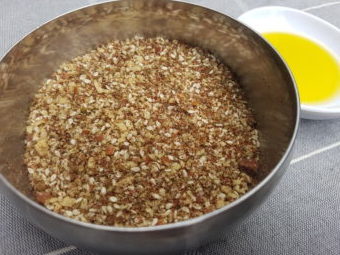
Dukkah Za’atar
Now exploring the other end of the fertile crescent, the Egyptian version of Za’atar, just like the others’, can be quite varied. Going by the name Dukkah or Duqqa, this blend most commonly doesn’t actually contain the main ingredients of za’atar; green herbs and sumac. …but then again, sometimes it does. What you see most often is a blend consisting of crushed nuts, usually hazelnut or chickpea, along with sesame seeds, cumin, coriander, salt, and black pepper. You can see the similarity to this combination with the za’atars of Syria and Turkey. From here families often add other ingredients, including marjoram, mint, za’atar, or other spices. Substituting different nuts is also common to see, such as pinenut, pistachio, cashews, or sunflower seeds.
In keeping with the theme of this page, the recipe I have created includes the essentials of the other za’atars; thyme, sesame seeds, sumac, and salt. I chose ground hazelnut for it’s traditionalism, along with the cumin and coriander.
[expand title=”See Dukkah Za’atar Recipe” swaptitle=”Hide Recipe” elwrapclass=”colomat-class”]
Dukkah Za’atar
By: Semiserious Chefs
Makes: ~3/4 cup of dukkah
Ingredients:
- 1/3 cup crushed/ground hazelnuts (~20 nuts)
- 1 1/2 T marjoram
- 1/2 T thyme
- 1 T sesame seeds
- 2 T sumac
- 1/2 t ground coriander
- 1/4 t ground cumin
- 1/2 t sea salt (or more to taste)
- 1/2 t ground black pepper
Directions:
- Use a mortar and pestle (or food processor) to break down the hazelnuts to a desired consistency.
- Grind the thyme down in the mortar and pestle until it isn’t ‘twiggy’, then add the marjoram and crush to bring out the aromas.
- Add the hazelnuts and green herbs to a small bowl with the sesame seeds, sumac, coriander, cumin, salt, and pepper. Stir to combine.
[/expand]
And now the grand finale! Our personal blend…
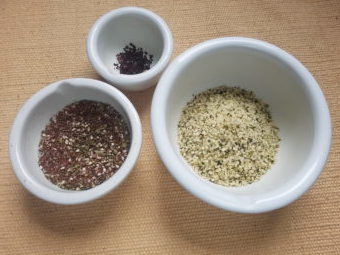
Secret ingredients to our personal blend: Urfa Biber and Hemp Hearts
Semiserious Za’atar
As we worked our way through the blends above, certain flavors really popped out for us. As for the basics, thyme is great, but the mint-sage combination really brings a bright freshness that we don’t often have in our cooking, so this we borrowed from the “Hyssop Substitute Za’atar.” Next the Sumac. I LOVE sumac, so our blend is heavy with it, not unlike the “Jordanian Za’atar.” Sesame seeds and salt are pretty straight forward so that leaves the spices. What spices? Yeah, I kept to just coarse ground pepper. I feel like I can get my cumin or coriander fixes elsewhere, and Andrew can’t stand anise so that was also ousted. Next came with our discovery of shelled hemp seeds. I love pistachios, and do like to add them when I have the chance, but being able to scoop out the perfectly textured hemp hearts, without any grinding is super convenient. You will probably find these prepackaged in the health food department. Lastly then, of course, I can’t resist the addition of one special ingredient. I’ve never seen anyone else’s za’atar recipe include any chili peppers, and I don’t think that just any kind of chili would be a good choice, but urfa biber is a must have both in my kitchen and in my za’atar.
These Turkish chili flakes are softer than your average red pepper flakes, with mild heat, and an almost coffee-chocolaty undertone. Allepo peppers would probably be a great alternative, but I hear they are hard to come by these days due to political unrest. If I didn’t have ufra biber I would probably not substitute red pepper flakes. For me, the flavor profile just isn’t the same, but that choice is always yours.
[expand title=”See Semiserious Za’atar Recipe” swaptitle=”Hide Recipe” elwrapclass=”colomat-class”]
Semiserious Za’atar
By: Semiserious Chefs
Makes: ~4 1/2 tablespoons of Za’atar
Ingredients:
- 1 t dried mint
- 1 t rubbed sage
- 2 T sumac
- 2 t sesame seeds
- 1/8 t coarse ground pepper
- 1/2 t urfa biber
- 1/8 t salt
- 1 T hemp hearts
Directions:
- Grind a few peppercorns coursely in a in a mortar and pestle, to equal 1/8 teaspoon. Add the mint and sage, and gently crush.
- Add this mix to a small bowl with the sumac, sesame seeds, urfa biber, salt, and hemp hearts.
- Enjoy!
[/expand]
